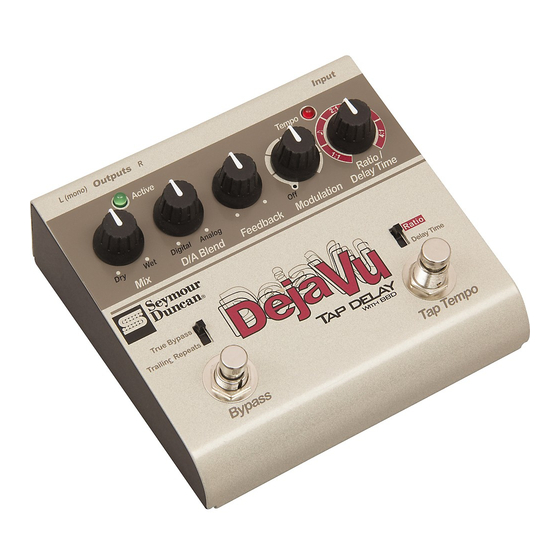Duncan SFX-10 Deja Vu Руководство пользователя - Страница 3
Просмотреть онлайн или скачать pdf Руководство пользователя для Музыкальная педаль Duncan SFX-10 Deja Vu. Duncan SFX-10 Deja Vu 17 страниц. Tap delay w/bbd

Explanation of Controls
Front Panel (See page 2)
1. Mix (dry-wet) – This control sets how loud the delays will be in rela-
tion to the original signal. Counter-clockwise produces dry only while
clockwise produces only delays. Remember, the dry signal is always
analog.
2. D/A Blend (digital-analog) – This amazing control unlocks the great-
est potential of the Déjà Vu. This is where the bucket brigade chip can be
engaged. Counter-clockwise, the digital delays are crystal clear, perfect
"better than CD" sound quality repeats. Clockwise, the tone is pure ana-
log bucket brigade, complete with all of its flaws.
3. Feedback – Decides how many repeats before the sound fades away.
Counter-clockwise, there will only be one repeat. Clockwise, the repeats
approach infinity and eventually runaway into mutated sounds of their
own. Beware!
4. Modulation – This knob affects the analog bucket brigade chip only.
This single knob morphs smoothly through multiple modulation set-
tings, beginning with slow, wide, and subtle, and ending with a jittery
warble perfect for slap back delays.
5. Ratio/Delay Time – This knob carries two functions. When in "Delay
Time" mode, this knob simply adjusts the rate of the delay effect from
3 ms counter clockwise, to 2600 ms clockwise. Longer delay times are
available when using the Tap Tempo footswitch (see below). Also, this
knob allows access to the Déjà Vu's loop mode. When the knob is fully
clockwise, the Déjà Vu enters Loop Mode. The LED behavior will invert,
from flashing the delay time to a constant beam that dips to show the
delay time. In this mode you simply press and hold the Tap Tempo foot-
switch like a "record button" while you're playing, and once you release
the footswitch the recording stops and immediately begins an infinite
loop, which you can now play over.
When in "Ratio" Mode, this control takes you through five tempo sub-
divisions: 1:1, "dotted 8th note" (or 1.33:1), 2:1, 3:1, and 4:1. Or another
way to look at it is quarter notes, dotted eighth notes, eighth notes,
triplets, and sixteenth notes. This is not a continuous control, but corre-
sponds to the five distinct sections marked on the outer band.
3
